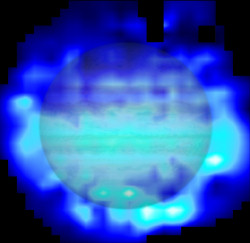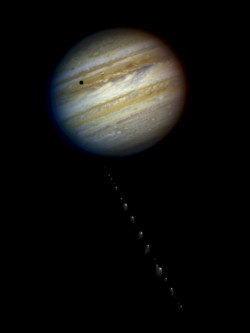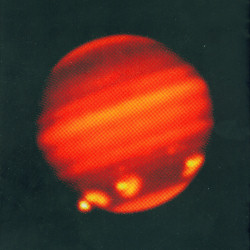Herschel links water in Jupiter's stratosphere to 1994 comet impact
23 April 2013
Astronomers have finally found direct proof that almost all water present in Jupiter's stratosphere was delivered by comet Shoemaker-Levy 9, which struck the planet in 1994. The result is based on new data from Herschel that revealed more water in Jupiter's southern hemisphere, where the impacts occurred, than in the north as well as probing the vertical distribution of water in the planet's stratosphere.
 |
| Distribution of water in Jupiter's stratosphere. Credit: Water map: ESA/Herschel/T. Cavalié et al.; Jupiter image: NASA/ESA/Reta Beebe (New Mexico State University) |
The origin of water in the upper atmospheres of the Solar System's giant planets has been debated for almost two decades. Astronomers were quite surprised at the discovery of water in the stratosphere – an intermediate atmospheric layer – of Jupiter, Saturn, Uranus and Neptune, which dates to observations performed with ESA's Infrared Space Observatory (ISO) in 1997. While the source of water in the lower layers of their atmospheres can be explained as internal, the presence of this molecule in their upper atmospheric layers is puzzling due to the scarcity of oxygen there – its supply must have an external origin. Since then, astronomers have investigated several possible candidates that may have delivered water to these planets, from icy rings and satellites to interplanetary dust particles and cometary impacts.
Answers are now starting to flow in from studies using ESA's Herschel space observatory. Herschel boasts unprecedented sensitivity as well as high spatial and spectral resolution at the far-infrared wavelengths, where many water emission lines can be observed. In 2011, a study based on Herschel data indicated that water in the stratosphere of Saturn is provided by its icy moon Enceladus; in 2012, the same origin was suggested for water in the atmosphere of Titan, another of Saturn's moons. Now it's the turn of Jupiter.
Soon after ISO's results, astronomers suspected that stratospheric water on Jupiter may have been, at least in part, supplied by comet Shoemaker-Levy 9, whose fragments famously hit the planet in July 1994. Until now, the claims were based on indirect evidence, such as the observations of carbon dioxide (CO2), which can be produced from the photo-chemistry of water; but the new Herschel data have yielded the long-sought direct proof.
 |
| Comet Shoemaker-Levy 9 approaching Jupiter in 1994. Credit: NASA, ESA, H. Weaver and E. Smith (STScI) and J. Trauger and R. Evans (Jet Propulsion Laboratory) |
"We have been eagerly looking forward to observing Jupiter with Herschel," comments Thibault Cavalié from the Laboratoire d'Astrophysique de Bordeaux, France, who led the study.
"Herschel has a unique combination of instruments that allowed us to perform a three-dimensional reconstruction of water in Jupiter's stratosphere: using PACS, we could map the distribution of water across the entire disc of the planet, and we probed the vertical profile of water in the stratosphere using HIFI. The combination of both data sets was crucial to linking the source of water to the famous cometary impact of almost 19 years ago," he adds.
Cavalié and his colleagues collected their first observations of Jupiter with PACS during Herschel's Science Demonstration Phase in late 2009, obtaining a set of spectra that coarsely spanned the planet's disc.
"The first observations were not yet optimised for the purpose of our study, but they already showed an asymmetric distribution of stratospheric water across Jupiter's disc. This first hint that water is overly abundant in the southern hemisphere motivated the rest of our observations," explains co-author Paul Hartogh of the Max-Planck-Institut für Sonnensystemforschung (MPS) in Katlenburg-Lindau, Germany. Hartogh is the Principal Investigator of the Herschel Key Programme 'Water and Related Chemistry in the Solar System' within which the observations were performed. "After all, Shoemaker-Levy 9 hit Jupiter at intermediate southern latitudes."
In 2010, the astronomers observed Jupiter again with PACS, this time gathering spectra at a much larger number of points across the planet's disc. This enabled them to obtain an accurate map of Jupiter's emission at 66.4 microns, a wavelength that corresponds to one of water's many spectral signatures. A comparison of this map with mid-infrared data from NASA's Infrared Telescope Facility (IRTF) that probe the atmospheric temperature indicated that the asymmetry in the water emission detected with Herschel is not linked to temperature fluctuations and must be due to an uneven distribution of water around the planet.
"The asymmetry between the two hemispheres suggests that water was delivered during a single event and rules out icy rings or moons as candidate sources," says Cavalié. "Local sources would provide a steady supply of water, which over time would lead to a hemispherically symmetric distribution in the stratosphere. Depending on whether the chemical species are transported in neutral or ionised form, local sources of water would result in higher concentrations either at the poles or along the equator, but not in a north-south asymmetry," he adds.
 |
| Jupiter after the impact of comet Shoemaker-Levy 9 in 1994. Credit: Calar Alto Observatory/Max Planck Institute for Astronomy, Heidelberg, Germany |
The PACS data, which enabled the astronomers to collect spectra across Jupiter's disc at great spatial resolution, were complemented with a set of high spectral resolution measurements from HIFI. Taken at 25 points across the planet's disc, these spectra were centred at 179.5 microns, another wavelength corresponding to an emission line of the water molecule.
"Exploiting the high spectral resolution of HIFI data, we could probe the vertical distribution of water across Jupiter's stratosphere," explains Hartogh, "This was our 'smoking-gun' proof to exclude other possible sources and confirm that at least 95 per cent of the water currently present in Jupiter's stratosphere was brought there by comet Shoemaker-Levy 9."
The HIFI spectra indicate that the bulk of water is confined to pressures lower than 2 millibars, corresponding to high stratospheric altitudes – well above the uppermost part of the troposphere. The troposphere lies below the stratosphere, in Jupiter's lower atmosphere, and its uppermost layer can be regarded as the visible planetary 'surface'. This part of the troposphere is also referred to as the 'cold trap' because it prevents water vapour from below to rise into the stratosphere, where it would condense into ice due to the low temperatures. For this reason, any trace of water in the stratosphere must have been delivered from an external source. Furthermore, the absence of water in the lower stratosphere pinpoints the origin of this water to a sporadic event: had it been brought by interplanetary dust particles, it would have had more time to be redistributed throughout the stratosphere and its vertical distribution would have extended to much lower altitudes.
The results do not exclude that interplanetary dust particles, icy rings and satellites or other cometary impacts may have brought water to Jupiter's stratosphere, but only in marginal amounts compared to that supplied by the 1994 impact.
"As the bulk of water we see in Jupiter's stratosphere was delivered at a single time in the past, we expect its content to slowly decline over the years, and we plan to keep monitoring Jupiter with the Swedish-led Odin spacecraft to study this decrement," says Cavalié.
Significant amounts of water will still be present in the planet's stratosphere by the 2030s, when ESA's Jupiter Icy moons Explorer (JUICE) mission will reach the Jovian system. Among other goals, the mission's Sub-millimetre Wave Instrument (SWI) will target a variety of molecules – including water – as tracers to study the circulation, winds and other phenomena in Jupiter's atmosphere.
"We are now certain that most water currently present in Jupiter's stratosphere is a remnant of the spectacular 1994 break-up and subsequent impact of comet Shoemaker-Levy 9," comments Göran Pilbratt, Herschel Project Scientist at ESA. "After showing that the water in Saturn's stratosphere, and possibly also in the atmosphere of Titan, is being provided by the moon Enceladus, Herschel has now clarified its origin in the largest of the giant planets, painting a diverse picture of the history of water in the Solar System."
Notes for editors
The study presented here is based on spectroscopic observations of Jupiter performed with the Photodetector Array Camera and Spectrometer (PACS) and the Heterodyne Instrument for the Far Infrared (HIFI) on board ESA's Herschel Space Observatory. The observations were performed as part of the 'Water and Related Chemistry in the Solar System' Key Programme, one of Herschel's Guaranteed Time Key Programmes.
The data were gathered at a number of different wavelengths corresponding to various emission lines of the water molecule. A first set of PACS data was collected around 58.7 μm and 65.2 μm on 8 December 2009, while a subsequent series of optimised PACS observations was performed around 66.4 μm on 10 December 2010. Observations at higher spectral resolution were performed with HIFI around 179.5 μm on 7 July 2010. The astronomers also used ground-based data gathered at shorter (mid-infrared) wavelengths with NASA's Infrared Telescope Facility (IRTF) on several occasions in 2009 and 2010.
The PACS instrument contains an imaging photometer (camera) and an imaging spectrometer. The camera operates in three bands centred on 70, 100, and 160 μm, respectively, and the spectrometer covers the wavelength range between 51 and 220 μm. PACS has been developed by a consortium of institutes led by MPE (Germany) and including UVIE (Austria); KU Leuven, CSL, IMEC (Belgium); CEA, LAM (France); MPIA (Germany); INAF-IFSI/OAA/OAP/OAT, LENS, SISSA (Italy); IAC (Spain). This development has been supported by the funding agencies BMVIT (Austria), ESA-PRODEX (Belgium), CEA/CNES (France), DLR (Germany), ASI/INAF (Italy), and CICYT/MCYT (Spain).
The HIFI instrument is a very high-resolution heterodyne spectrometer and operates in seven bands covering the wavelength range between 157 and 625 µm. HIFI has been designed and built by a consortium of institutes and university departments across Europe, Canada, and the United States under the leadership of SRON Netherlands Institute for Space Research, the Netherlands, with major contributions from Germany, France, and the US. HIFI Consortium members are: CSA, U. Waterloo (Canada); CESR, LAB, LERMA, IRAM (France); KOSMA, MPIfR, MPS (Germany); NUI Maynooth (Ireland); ASI, IFSI-INAF, Osservatorio Astrofisico di Arcetri-INAF (Italy); SRON, TUD (Netherlands); CAMK, CBK (Poland); Observatorio Astronómico Nacional (IGN), Centro de Astrobiología (CSIC-INTA) (Spain); Chalmers University of Technology - MC2, RSS & GARD, Onsala Space Observatory, Swedish National Space Board, Stockholm University – Stockholm Observatory (Sweden); ETH Zurich, FHNW (Switzerland); Caltech, JPL, NHSC (USA).
Related publications
T. Cavalié, et al., "Spatial distribution of water in the stratosphere of Jupiter from Herschel-HIFI and PACS observations", 2013, Astronomy & Astrophysics, 553, A21; doi: 10.1051/0004-6361/201220797
Contacts
Thibault Cavalié
Laboratoire d'Astrophysique de Bordeaux (CNRS-INSU; University Bordeaux 1)
Floirac, France
Email: Thibault.Cavalie![]() obs.u-bordeaux1.fr
obs.u-bordeaux1.fr
Phone: +33-5-57-77-61-24
Paul Hartogh
Max-Planck-Institut für Sonnensystemforschung
Katlenburg-Lindau, Germany
Email: hartogh![]() mps.mpg.de
mps.mpg.de
Phone: +49-5556-979342
Göran Pilbratt
Herschel Project Scientist
Research and Scientific Support Department
Science and Robotic Exploration Directorate
ESA, The Netherlands
Email: gpilbratt![]() rssd.esa.int
rssd.esa.int
Phone: +31-71-565-3621



